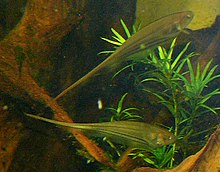
The Gymnotiformes are an order of teleost bony fishes commonly known as Neotropical knifefish or South American knifefish. They have long bodies and swim using undulations of their elongated anal fin. Found almost exclusively in fresh water, these mostly nocturnal fish are capable of producing electric fields to detect prey, for navigation, communication, and, in the case of the electric eel, attack and defense. A few species are familiar to the aquarium trade, such as the black ghost knifefish, the glass knifefish, and the banded knifefish.

The naked-back knifefishes are a family (Gymnotidae) of knifefishes found only in fresh waters of Central America and South America. All have organs adapted to electroreception. The family has about 43 valid species in two genera. These fish are nocturnal and mostly occur in quiet waters from deep rivers to swamps. In strongly flowing waters, they may bury themselves.

The ghost knifefishes are a family, Apteronotidae, of ray-finned fishes in the order Gymnotiformes. These fish are native to Panama and South America. They inhabit a wide range of freshwater habitats, but more than half the species in the family are found deep in rivers where there is little or no light.
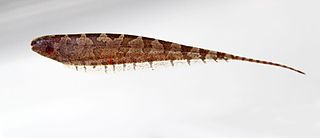
The Hypopomidae are a family of fishes in the order Gymnotiformes known as the bluntnose knifefish. They may also be called grass or leaf knifefishes. These electric fish are not often eaten, of little commercial importance, rarely kept as aquarium fish, and poorly studied; however, species in this family may constitute a significant fraction of the biomass in the areas they inhabit.

The banded knifefish is a species of gymniform knifefish native to a wide range of freshwater habitats in South America. It is the most widespread species of Gymnotus, but it has frequently been confused with several relatives, including some found outside its range like the Central America G. maculosus. The English name "banded knifefish" is sometimes used for the entire genus Gymnotus instead of only the species G. carapo.

Magosternarchus is a genus of weakly electric knifefish in the family Apteronotidae, containing two species. They are endemic to Brazil, occurring in large river channels in the Amazon River basin. Both species are unusual benthic predators that specialize in biting off the tails of other knifefishes, and are characterized by their greatly enlarged jaws and teeth. Recent systematic studies indicate that both species should be included in Sternarchella instead of being placed in their own genus.
Sternarchogiton nattereri is a species of weakly electric knifefish in the family Apteronotidae. It is native to the Amazon River system and feeds on sponges. Unlike other members of the genus Sternarchogiton, there is pronounced sexual dimorphism in S. nattereri, with reproductively mature males developing strong external teeth on tips of their jaws. These males are so different from the females and juveniles that they were thought to be a different genus and species, the "tooth-lip knifefish" Oedemognathus exodon, for over 40 years.
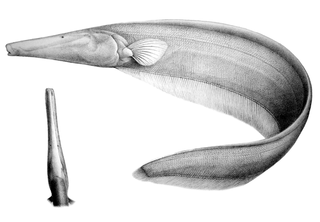
Orthosternarchus tamandua, the tamandua knifefish, is a species of weakly electric knifefish in the family Apteronotidae, native to the deep river channels of the Amazon basin. This species is characterized by its whitish-pink color, long tubular snout, long dorsal appendage, and tiny, bilaterally asymmetrical eyes.
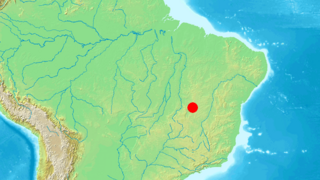
Eigenmannia vicentespelaea is a species of weakly electric knifefish in the family Sternopygidae. Native to the São Domingos karst area in central Brazil, it is the only known knifefish to exclusively inhabit caves. Measuring up to 21 cm (8.3 in) long, E. vicentespelaea can be distinguished from its relatives by its translucent body and reduced or absent eyes. As some individuals retain well-developed eyes, this fish may have colonized caves only recently in evolutionary time.
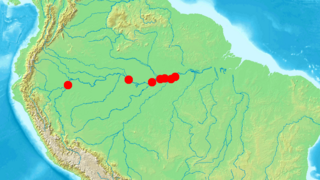
Pariosternarchus amazonensis is a little-known species of weakly electric knifefish in the family Apteronotidae, and the only member of the genus Pariosternarchus. It is found in the main channel of the Amazon River in Brazil and Peru, likely near the bottom in deep, fast-moving water. This species is characterized by a wide head with a flat bottom, and very large sensory canals along the lower jaw. Like several other knifefishes found in deep river channels, it has reduced eyes, scales, and body pigmentation.
Hypopygus is a genus of South American gymnotiform knifefishes native to the Amazon, Orinoco and upper Paraguay basins, as well as rivers in the Guianas. They are often common, and found near submerged roots, aquatic vegetation and leaf-litter in streams, edges of rivers and floodplains. They are regularly found among vegetation in floating meadows, a habitat that often contains little oxygen, but they are well-adapted to this.

Steatogenys is a genus of gymnotiform knifefishes found in the Amazon, Orinoco and Essequibo river basins in tropical South America. The widespread and common S. elegans is found in a wide range of habitats, from the shallow essentially static waters such as floodplain lakes to fast-flowing rivers as deep as 50 m (160 ft). The two remaining species are less common and widespread, with A. duidae found mainly in small streams running through terra firme forests and S. ocellatus among submerged roots and branches in static or slow-flowing blackwater habitats. All three are regularly found among vegetation in floating meadows, a habitat that often contains little oxygen, but they are well-adapted to this.

Rhamphichthys(Rhamphos = Greek for beak and Ichthys = Greek for fish) is a genus of fish that includes the South American sand knifefish. These fish are eel shaped with a distinct beak like snout which gave them their name. Like most other knifefish Rhamphichthys species have electrical organs that help them live in the murky waters of South America. Currently there are 10 recognized species of Rhamphichthys, although many changes have been made in their taxonomy since their original discovery.
Distocyclus is a genus of South American glass knifefishes, with one species in the Amazon basin and another in rivers in French Guiana.

Eigenmannia is a genus of fish in the family Sternopygidae native to tropical and subtropical South America, and Panama. They are typically found in slow-flowing streams, along the edge of large rivers, in deep river channels and in floodplains, and the genus also includes E. vicentespelaea, the only cave-adapted knifefish. Eigenmannia are often found near submerged roots, aquatic plants and floating meadows.
Rhabdolichops is a genus of glass knifefishes found in Amazon, Orinoco and Maroni basins in tropical South America. They live near the bottom in main river channels, floodplains and lagoons, and are typically found in relatively deep waters.

Sternopygus is a genus of glass knifefishes found in tropical and subtropical South America, and Panama. They inhabit a wide range of freshwater habitats, from fast-flowing rivers to essentially static waters in floodplains, and shallow habitats to the bottom of deep rivers. S. macrurus will even visit brackish mangrove to feed.
Distocyclus conirostris is a species of glass knifefishes found in the deep waters of the Amazon basin, lower portions of the Potaro River and in major parts of the Rio Orinoco. They are typically relegated to flood basins, flooded forests and main river channels. They have often been found gathering in small groups around vegetation, indicating a social nature. The fish has semi-translucent, glass-like pectoral and anal fins. The main body is a ground-like color with a lighter head. The largest currently recorded specimen is 34.5 cm.

Steatogenys elegans, the barred knifefish, is a species of Hypopomidae found in tropical South America. It is the type species of its genus. It is an electric fish found in a wide range of freshwater habitats in the Amazon, Orinoco and Essequibo river basins. It reaches almost 30 cm (1 ft) in total length.
Humboldtichthys is an extinct genus of glass knifefishes from the Miocene Yecua Formation of Bolivia. A single species is currently recognized: Humboldtichthys kirschbaumi.
